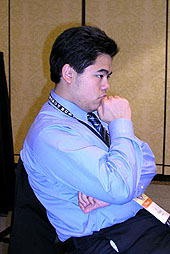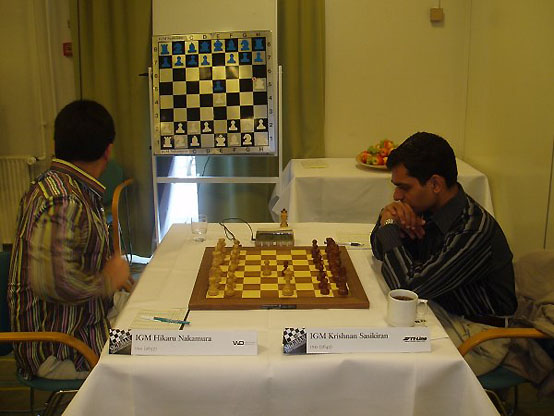 |
 |
 |
 |
 |
 |
 |
 |
 |
 |
 |
 |
 |
 |
 |
 |
 |
 |
|
|
|
|
|
|
|
|
|
|
|
|
|
|
|
|
|
|
|
|
 |
|
|
|
|
|

|
|
|
|
|

|
|

|
|

|
|
|
|
|
|
|
|
|
Hikaru Nakamura trots out 2.Qh5 against Krishnan Sasikiran of India.
|
|
|
|
|
|
|
|
|
|
|
|
|
|
Hikaru Nakamura has caused a controversy by employing a line which breaks all standard rules of chess… 1.e4 e5 2.Qh5!? We are often taught that bringing the queen out early is a bad principle, but we have to look no further than Bernard Parham I, to find the top advocate of 2.Qh5. Parham is the creator of "Matrix Chess" which features the infamous 2.Qh5 as a standard order of play.
No reports have been filed as to why the 17-year old U.S. Champion was inspired to play this move sequence against the strong Indian Grandmaster, Krishnan Sasikiran (at the Sigeman GM tournament). It has been reported that he has been testing it in blitz games. However, players at the ICC and commentators have expressed mixed reviews. Some feel that it is an insult to play such a line against Grandmaster opponents while others feel that it is refreshing that such a move could be played and a reasonable position reached. At one time, the Center Counter game (1.e4 d5!?) was thought to be an insult, but it has garnered the respectable reputation. Here's what the main website said about Nakamura's adventure:
|
|
|
|
|
|
|
|
|
|
|
|
|
|
Nakamura surprised Sasikiran with what looked suspiciously like an attempt at fool's mate (1.e4 e5 2.Dh5!?, what is this opening called!?). Around move 35, Nakamura compromised himself positionally in an attempt to play for a win (without really spending any time on this decision). A little while later, he sacrificed a pawn without any obvious compensation. Commentator GM Lars Bo Hansen meant that decisions of this type are not to be recommended against strong GMs like Sasikiran. Sometimes you have to accept that your opponent has earned a draw by defending well!? Lars Bo Hansen meant that Nakamura will have to learn this if he wants to be able to match +2750 players in the future. However, Lars Bo also meant that it would be great for chess if Nakamura would establish himself at the very top with his "I want to win all games" attitude. No matter what, the spectators love it and so do the Sigeman organizers.
|
|
|
|
|
|
|
|
|

|
|
|
|
|
|
|
|
|
|
|
|
GM Hikaru Nakamura
(U.S. Chess Champion)
|
|
|
|
|
|
|
|
|
|
|
|
|
|
|
|
|
Nakamura lost the game, but it was not because of his second move. He reached a good position and had chances to wrest the initiative with 25.Bxg7! Sasikiran defended accurately, but Nakamura played for more and lost the thread on the position. Nakamura's "Matrix Experiment" will cause players to perhaps take a glance or two at the opening the way players examined the Evans Gambit after Garry Kasparov demolished Viswanathan Anand in 25 moves.
Does this mean that 2.Qh5 will enter the mainstream of chess opening? Hardly. However, it again shows why Hikaru Nakamura stands as a lightening rod of excitement for a moribund sport. I do believe that the chess public will mistake his loss as a failure of the opening as people refuse to acknowledge that Nakamura got a good position. Bobby Fischer, who states that old chess is dead, has undoubtedly looked at Nakamura-Sasikiran. It would be interesting to hear what he thinks of this 2.Qh5 move.
See Hikaru Nakamura-Krishnan Sasikiran!
|
|
|
|
|
|
|
|
|
|
 |
|
|
|
|
|

|
|
|
|
|
|
|
|
|
|
Hikaru Nakamura appears to glance at 2.Qh5!? on the demo board
as Krishnan Sasikiran ponders. Photo by Sigeman & Co.
|
|
|
|
|
|
|
|
|
|
|
|
|
|
|
|
 |
|
|
|
|
|
 |
|





